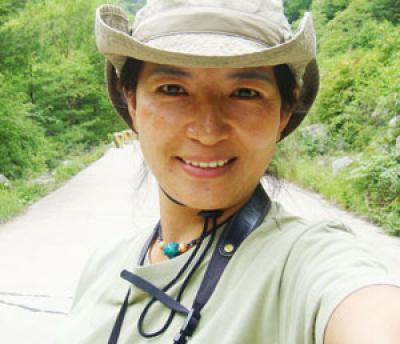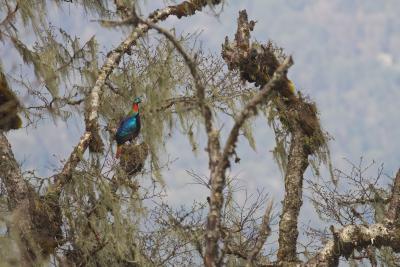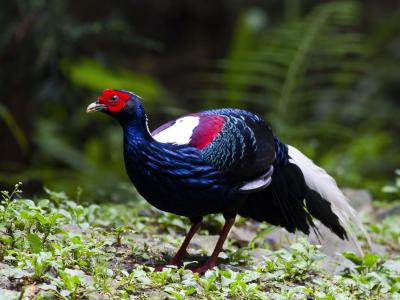China: Yunnan Province
-
Mar 8-23, 2025
Paul Holt and Wang Qingyu
Lying in the most south-western corner of China, Yunnan Province has received little attention from birders and yet it holds some of the most exciting habitats and alluring species in the whole of Asia. The area’s close proximity to Myanmar (formerly Burma) coupled with the ease of travel - good roads, often excellent hotels, and superb food – combine to produce a comfortable tour with some really special birds.
We’ll visit several areas in western Yunnan including a number of sites close to the border with Myanmar. The entire area, much of it on the Ancient Southern Silk Road, is a historical treasure trove replete with numerous attractions. We’ll start by visiting the border town of Ruili, one also blessed with good quality forest on its door step. Here we’ll look for species including Pin-tailed Green Pigeon, Cook’s Swift, Stripe-breasted Woodpecker, Red- and Coral-billed Scimitar-babblers, Scarlet-faced Liocichla and Pale-billed Parrotbill.
We’ll then move to Yingjiang, a smaller town that’s also close to the Myanmar border. Sought-after species here include Grey Peacock-pheasant, Great Slaty Woodpecker, Blue-naped Pitta and Collared Myna while other specialties could include both Collared Treepie and Vinous-breasted Starling. We’ll continue to Tengchong, both historic settlement and scenically stunning with its surround of a cluster of young volcanoes. We’ll concentrate here on finding Brown-winged Parrotbill and Slender-billed Oriole.
Gaoligongshan, our next port of call, was featured in the BBC’s Wild China TV series, and it’s easy to see why. Early 20th century naturalist-adventurers such as Frank Kingdon Ward explored much of this area and among the rich plant flora (the Nature Reserve boasts over 1,400 species of higher plants) we’ll search for avian delights such as Spot-breasted Parrotbill, Cachar Wedge-billed Babbler, Gould’s Shortwing and Black-breasted Thrush. Our final port of call will be historic Lijiang, a UNESCO World Heritage site famed for its distinctive architecture. The skyline of this quaint town is dominated by Jade Dragon Snow Mountain, a year round snow-capped peak that reaches almost 18,500 feet, and it’s the woodlands near there where we’ll search for another specialty, Yunnan Nuthatch. Nearby we’ll also hunt for Lady Amherst’s Pheasant, the severely threatened White-speckled Laughingthrush, Rufous-tailed Babbler and Black-bibbed Tit before heading back to Beijing.
Day 1: The tour begins this evening in Beijing.
Day 2: This morning we’ll connect with a flight south to Mangshi in western Yunnan. It’s unlikely that we’ll arrive in time to do any birdwatching. Night in Mangshi.
The birds were wonderful and the scenery terrific. The group size made the birding fun. Paul was a very capable guide and great birder. Wang Qingyu was amazing. - Bryan S.
Days 3-4: We’ll head south from Mangshi to Ruili. Known as the home of the Dai ethnic group, Ruili is bordered on three sides by Myanmar and is a large, prosperous border settlement. The import of gems, jade ware and jadeite from neighboring Myanmar have helped create China’s largest jewel market. Many of the low lying ridges immediately around Ruili are still also covered in good quality forest and we’ll concentrate on finding some of this area’s specialties. These include the likes of Jerdon’s Baza, Pin-tailed Green Pigeon, Brown Wood Owl, Stripe-breasted Woodpecker, Black-throated and Rufous-necked Laughingthrushes, Scarlet-faced Liocichla, Pale-footed Bush Warbler as well as both Pale-billed (previously Lesser Rufous-headed) and Rufous-headed Parrotbills. With a bit of luck we might also come across a Hodgson’s Frogmouth or a Spot-throated Babbler. Nights in Ruili.
Day 5: After another morning near Ruili, we’ll drive to Yingjiang, a smaller settlement than Ruili but one that’s also nestled close to the Myanmar border. We should arrive in time to do a little birding, perhaps seeing Little Pratincole, Black-breasted Thrush and Collared Myna around town. Night in Yingjiang.
Days 6-7: Spending two full days around the tiny border settlement, we’ll have ample time to search for the area’s lower elevation specialties such as Grey Peacock-pheasant and Spot-bellied Eagle Owl, both genuinely rare and decidedly elusive, but others, hopefully including Blossom-headed Parakeet, Collared Falconet, Blue-bearded Bee-eater, Red-billed and perhaps even Coral-billed Scimitar Babblers, Rufous-capped and Yunnan Fulvettas are less so. The forests here abound with birds and in our quest to see a representative sample of them, we’ll explore severalf forest trails and a small reserve not very far from our hotel. This is the best area in the whole of China for seeing species such as Oriental Pied, Great and Wreathed Hornbills, White-hooded Babbler and Golden-crested Mynas as well as White-tailed, Sapphire and Hill Blue Flycatchers. At times Myanmar will only be a stone’s throw away, and the river we’ll bird along is actually the border, so we’re sure to add species to our embryonic Myanmar list as we go.
Day 8: After a final morning near Yingjiang we’ll drive onto Tengchong, an area famed for ia mild climate, iancient volcanoes, and geothermal springs. Tengchong also played an important role during the Second World War when Allied pilots flew sorties over ‘the hump’, resupplying Chinese forces fighting the Japanese. We’ll spend the night in a comfortable hotel in Tengchong.
Day 9: We may be awakened by the attractive song of Black-breasted Thrush - the first of a handful of Tengchong specialties. A pleasant bird-thronged park holds our other targets - Mountain Bamboo Partridge, the localised Brown-winged Parrotbill and Slender-billed Oriole among others, and we’ll spend several hours here before heading on to Baihualing.
Our spectacular route takes us through deep valleys and across impressive dividing ranges. While the roads are now excellent and our progress likely to be rapid and easy, this wasn’t always the case. Indeed it’s the region’s former remoteness that has kept it an intact, vast refuge for an extraordinarily rich biodiversity. The Gaoligong range, sandwiched between the mighty Salween (Nujiang) river and neighboring Myanmar encompasses habitats ranging from subtropical evergreen forests to snow-capped peaks and glaciers at over 20,000 feet. We’ll likely be enthralled by the richness of the fabulous Gaoligong forests – forests that several early plant hunters, such as George Forrest and Frank Kingdon Ward (themselves immortalised by plant and birds that carry their names) explored for rhododendrons and other garden-worthy plants. We’ll spend three nights in a comfortable, new guest house on the edge of the reserve.
Days 10-11: Two full days based at Baihualing right in the heart of Gaoligong Shan’s incredibly varied forests will give us time to find some of its avian wonders. In stands of bamboo we’ll search for Broad-billed Warbler and Slender-billed Scimitar Babbler while deep forest gullies will hold more secretive species such as the often reticent Cachar Wedge-billed Babbler, Spotted and Grey-bellied Wren Babblers, Blue-winged and the gorgeous Red-tailed Laughingthrush. We’ll explore several forest trails, including one that was previously part of the Southern Silk Road. Other special species should include Black-headed and Blyth’s Shrike Babblers, Beautiful Sibia, Spot-breasted Parrotbill and with luck, even Gould’s Shortwing. Three tesias, Slaty-bellied, Grey-bellied and Chestnut-headed, also inhabit the mossy, lush forest. Hill and Rufous-throated Partridges are, unfortunately, both much more likely to be heard than seen while other secretive forest denizens include both Silver and Mrs. Hume’s Pheasants. There’s now a series of bird blinds, constructed by enterprising locals for Chinese bird photographers, and we hope to be able to visit at least a couple of these during our stay as they can afford spectacular views (and marvelous photographic opportunities) of a number of rarely seen east Himalayan specialties.
Day 12: After a final morning we’ll leave Baihualing and the mighty Gaoligong Mountain range for a short drive north to Baoshan.
Day 13: Leaving Baoshan early we’ll have a half-day’s drive north to Lijiang. We expect to arrive in Lijiang in time to do some local birding and will spend the night in a very comfortable hotel right on the edge of Lijiang’s historic old town. Originally inhabited eight centuries ago by the ethnically distinctive Naxi cultural group, Lijiang is an extremely attractive modest-sized town. Once a center for trade along the old pack horse road, Lijiang old town is famous for its orderly Naxi architecture with its distinctive system of waterways and bridges. Recently designated a UNESCO World Heritage site, Lijiang is now a booming tourist resort with equal numbers of visitors drawn to the town’s rich cultural heritage and to the nearby Jade Dragon Snow Mountain, a year-round snow-capped peak that boasts the northern hemisphere’s southernmost glacier. At almost 18,500 feet, this impressive mountain dominates the town’s skyline – and remains proudly unclimbed! Time permitting we’ll either spend the late afternoon searching for Yunnan Nuthatch, the province’s only endemic bird, or exploring Lashihai, a bird-thronged lake a short distance to the west of town where we hope to see Falcated and Ferruginous Ducks, while small flocks of Common Crane strut amid the tiny fields where Black-headed Greenfinches also feed. Night in Lijiang.
Day 14: We’ll spend most of the day around picturesque Lijiang and will leave early for a site where the poorly known and globally threatened White-speckled Laughingthrush was recently discovered. It’s extremely rare and persecuted so our chances of finding one are slim. Other target species in the rich forests here include the fabulously inquisitive Rufous-tailed Babbler, Black-bibbed Tit, vociferous but melancholy Black-headed Sibia, Black-streaked Scimitar-babbler, Chinese Babax, Elliot’s Laughingthrush, Rusty-capped and Spectacled Fulvettas, White-collared Yuhina. Night in Lijiang.
Day 15: After a final morning in Lijiang we’ll take a flight to Kunming, Yunnan’s provincial capital, before another from there back to Beijing. Night near Beijing International Airport.
Day 16: The tour concludes this morning with transfers back to the airport.
Note: The information presented below has been extracted from our formal General Information for this tour. It covers topics we feel potential registrants may wish to consider before booking space. The complete General Information for this tour will be sent to all tour registrants and of course supplemental information, if needed, is available from the WINGS office.
ENTERING CHINA: United States citizens will need a passport valid for at least six months from date of departure and with at least two blank pages for entry and exit stamps. A tourist visa is also required. Visa information is available from the Chinese Embassy, Washington DC at http://www.china-embassy.org/eng/ . If required by the embassy or visa-granting entity, WINGS can provide a letter for you to use regarding your participation in the tour.
COUNTRY INFORMATION: You can review the U.S. Department of State Country Specific Travel Information here: https://travel.state.gov/content/travel.html and the CIA World Factbook here: https://www.cia.gov/the-world-factbook/. Review foreign travel advice from the UK government here: https://www.gov.uk/foreign-travel-advice and travel advice and advisories from the Government of Canada here: https://travel.gc.ca/travelling/advisories.
PACE OF TOUR AND DAILY ROUTINE: This is not an easy tour. There is a fair amount of travelling and several of the days are long and tiring. There is as well a considerable amount of walking involved although none of it is particularly strenuous. Although we are in mountainous area for much of the tour there will only be a few uphill walks and these will be taken at a gentle pace. See “HEALTH”, below, for the altitudes we reach on the tour. If you have any questions about your ability to take part in any of the walks, please contact the WINGS office. The tour manager will be happy to discuss this with you.
Sunrise in western Yunnan at this time of year is at about at 7:15 am and sunset at around 6:30 pm. On a clear and cloudless day, it is usually sufficiently light to bird watch for 20 minutes either side of these times. Due to the early morning bird activity, we will want to be out in the field early each day. This will occasionally mean being out before 7:00 am. Throughout most of China, hotel breakfasts are rather poor so on a good number of days we will have picnic breakfasts provided for us by our ground agent. These will usually consist of cereal (often muesli or cornflakes), yoghurt, fruit juice, instant noodles, biscuits, muffins, bread with jam or possibly honey, peanuts, sausages and boiled eggs plus tea and coffee and supplemented, where possible, by fruit, chocolate and steamed local bread.
Depending on the weather we’ll probably either have picnic breakfasts in the leader’s room or out in the field before we start our birding. We expect to have picnic lunches almost every day (on wet or very windy days we may return to the hotel for lunch) and will compile a checklist of the birds we’ve seen just before or just after dinner (usually about 7:00 pm in our hotel) and then retire early to bed (especially when we are making an early start next day).
We will occasionally have more than one vehicle with us and the emphasis will be on flexibility. We will try to make as many of our birding excursions as possible optional, so that so that anyone who is tired, or would like a break can take some time off. Essentially, we aim to provide dawn to dusk birding for those who want it and as many opportunities as possible to opt out for those who wish to pursue other interests or simply relax. Note that we are frequently moving on, and it is not always possible to take an entire day off.
HEALTH: The Centers for Disease Control and Prevention (CDC) recommends that all travelers be up to date on routine vaccinations. These include measles-mumps-rubella (MMR) vaccine, diphtheria-tetanus-pertussis vaccine, varicella (chickenpox) vaccine, polio vaccine, and your yearly flu shot.
They further recommend that most travellers have protection against Hepatitis A and Typhoid.
Please contact your doctor well in advance of your tour’s departure as some medications must be initiated weeks before the period of possible exposure.
The most current information about travelers’ health recommendations can be found on the CDC’s Travel Health website here: https://wwwnc.cdc.gov/travel/destinations/list
Malaria: Malaria exists in Yunnan Province, especially along the Myanmar border. The CDC suggests a malaria prophylaxis. Please consult your physician.
Altitude: We’ll reach a maximum altitude of just over 9000 feet on one day and much of our birding will be between 5000 and 6000 feet. We have one hotel night at about 8000 feet.
Miscellaneous: Very few biting insects are active in South China in winter, but there still may be isolated concentrations of day-flying mosquitoes at one or two sites. We recommend that you bring an insect repellent and, if you are sensitive to bites, an antihistamine. On some of the forest trails during the early part of the tour we may encounter a very few small terrestrial leeches. These are well known to travellers in Asia and are not harmful. They are found on the forest floor and the best way to prevent them from getting onto your ankles is to spray your boots with insect repellent.
Tap water is not safe to drink anywhere in China. Bottled water and soft drinks are widely available. We will provide bottled water in the vehicle during the day.
Smoking: Smoking is not allowed in the vehicle, at meal times or when the group is gathered together for the checklist. If you are sharing a room with a non-smoker, please don’t smoke in the room. If you smoke in the field, please stand down wind of the group. If any lodge, accommodation or location where the group is staying or is gathered has a more restrictive smoking policy than WINGS’ policy, the more restrictive policy will prevail. Note: None of the hotels that we’ll use have designated non-smoking rooms so the rooms we use might have been previously occupied by a smoker. While the bed linen will certainly be clean, cigarette odors in the bed rooms are fairly common. Note too that many Chinese men, and an increasing number of women, smoke heavily. We will not permit our drivers or locals guides to smoke in our vehicle or in close proximity to the group but we have no control over anyone else and inquisitive strangers may come up to us and smoke nearby. Moreover while we will eat most, if not all of our sit down meals in private dining rooms very occasionally we might have to eat in the common dining hall where there might be smokers. This does not happen on every tour, or even on every other tour, but it can happen.
CLIMATE: The average daytime temperatures on this tour can range from as low as 2 or 3°C (36 or 37F) to possibly as hot as 31°C (88F). Days with highs in the 70-80 F range are the norm. Humidity is usually low and conditions for birding are often ideal.
Precipitation is infrequent but possible, particularly in the Gaoligong Mountains, and as mentioned above, may fall as snow at Lijiang.
ACCOMMODATION: We stay in a variety of hotels from excellent 5-star equivalent hotels with all the amenities that you would expect from hotels of this standard such as a bar, a business centre, internet access in the rooms, a gym and an indoor swimming pool, to standard Chinese hotels where all the rooms have en suite bathrooms with western toilets, showers and 24 hours hot water. In one case we stay three nights in a nature reserve guest house This is the simplest place we stay but the rooms are clean - each has two beds, 24 hours electricity and an en suite bathroom with hot showers and western toilet. Please note that single rooms cannot be guaranteed here – we will try our best but there simply aren’t very many rooms available.
FOOD: Chinese cuisine is well known and widely appreciated. Beer, soft drinks and green tea will be served with the meal. Western brands of alcohol are not always easily obtainable (and where they are available, they are usually expensive), so you may wish to consider bringing your own supply. The Chinese often also drink a hard liquor, bai-jiu, with the food.
The Chinese way of eating differs from that in the west in that those sitting at the table share selections of different dishes. Food is almost always plentiful. Only a small number of the restaurants that we’ll visit provide knives and forks. Instead chopsticks, often disposable wooden ones, are used.
In contrast to evening meals, typical Chinese breakfasts are disappointingly poor and unappealing to most westerners. They consist mostly of cold dishes – soya milk, steamed dumplings and rice porridge. Consequently, away from the international style hotels in Lijiang, Tengchong and Beijing where a variety of more western style dishes are available, we will, as noted above, have very few hotel breakfasts.
Drinks: Bottled water and/or a soft drink or a beer is provided at sit down lunches and dinners, as is coffee or tea.
Food Allergies/Requirements: We cannot guarantee that all food allergies can be accommodated at every destination. Participants with significant food allergies or special dietary requirements should bring appropriate foods with them for those times when their needs cannot be met. Announced meal times are always approximate depending on how the day unfolds. Participants who need to eat according to a fixed schedule should bring supplemental food. Please contact the WINGS office if you have any questions.
TRANSPORTATION: At the start of the tour we will fly from Beijing to Baoshan via Kunming while at the end of the tour we will fly from Lijiang back to Beijing. Most of our other journeys will be by a small minibus or coach.
Tour participants should be willing and able to ride in any seat in our tour vehicles.
2019 Narrative
A quick perusal of the end of tour ‘Bird of the Trip’ list gives a good indication of just how successful this year’s Yunnan tour was. The network of photographic blinds that have been so popular at Yingjiang and in the Gaoligong Mountains on our previous tours continue to be expanded and there were now multiple offerings at both these sites. And boy, did we see birds from these blinds! It’s a testimony to their success that eight of the top 11 birds in the end of trip ‘Bird of the Tour’ poll were seen exclusively from one or more of these blinds. While our hide-based encounters with Red-tailed Laughingthrush, Mrs. Hume’s Pheasant, Rufous-throated Partridge, and Golden Bush-robin came as no surprise, March 2019 was the first time that we’d ever seen a White-gorgeted Flycatcher or a Kalij Pheasant from one, and Paul, who has now been to Yunnan 20 times, had never come remotely close to seeing many of the species we encountered anywhere near as well as we did on this tour. Winner of the poll was again Red-tailed Laughingthrush – and at one stage we had at least nine of these gorgeous yet combative gems creatures competing for our attention from Baihualing blind - 8 on the 17 March, at least 10 from Baihualing hide and 11 the very next day!
And then there was the back-up: the White-crested, Black-throated, Scaly, Blue-winged, Grey-sided, Moustached and Black-faced Laughingthrushes; the Grey Peacock-pheasants (including a female with a single diminutive chick), the well-appreciated Golden Bush Robins, the Silver-eared and Red-billed Leiothrix, the minlas, Scarlet-faced Liocichlas, Chestnut-headed Tesias, the Mountain Bamboo Partridges and the White-browed Shortwing. All performed superbly.
Our introduction to birding in Yunnan was at Moli Tropical Forest Park between Mangshi and Ruili – and what an introduction it was! The 1.5 kilometre stretch of flat road between the entrance gate and the carpark took us almost three hours to walk, but then there were distractions such as our first Rosy Minivet even before we’d stepped inside the park gates which came as no surprise. A Jerdon’s Baza checked us out immediately after breakfast while other encounters included several skulking Grey-bellied Tesias and Streaked Wren-babblers; exciting encounters with White-hooded Babblers, Pale-billed and Rufous-headed Parrotbills and the three species of forktail along a short 200 metres stretch of stream. And then there were the first of Qingyu’s breakfasts and lunches. What a start to our Yunnan birding bonanza!
After lunch we visited a now defunct smaller tropical park right on the border with Myanmar and scored here as well with a handful of new species including our first Black-breasted Thrushes and a Yellow-bellied Prinia. The latter even found its way onto our Myanmar lists.
The following day saw us exploring a forested ridge close to Ruili town and, with over 130 species logged between us, this was the most bird-rich day of the entire tour. Here again birds came thick and fast with fabulous looks at a Brown Wood Owl and a close-range Grey Nightjar even before the sun came up! Following those were 10 Cook’s Swifts (a recent split from Pacific Swift), a fabulous vocal party of Red-billed Scimitar Babblers, a flock of three Greater Yellownapes, close range telescope looks at a Spotted Elachura, and more parrotbills in the form of four Grey-headed. After being entertained by a displaying Crested Goshawk and a group of schoolchildren during lunch, a short afternoon walk yielded no less than three Streak-breasted Woodpeckers and our first Burmese Shrike.
The following day was only marginally less species-rich and its highlights included our one and only Spot-winged Grosbeak (a fine singing male), no-less-than 25 Mountain Imperial Pigeons, great looks at a Banded Bay Cuckoo, our first Coral-billed Scimitar Babblers, several more Rufous-backed Sibias, and an elusive Grey-bellied Wren Babbler. That afternoon the Yingjiang river yielded the hoped for Small Pratincoles and River Terns.
The network of photographic blinds that have proved so popular in the Gaoligong Mountains on our previous tours have more recently been expanded and there are now almost as many in the lower elevation forests to the southwest of Yingjiang. Highlights of our time there included Grey Peacock-pheasant (we’d see five and heard at least six others); a resplendent male Kalij Pheasant, three Collared Falconets, a ‘Shaheen’ Peregrine Falcon carrying a Hair-crested Drongo, a stunning male Red-headed Trogon, half-a-dozen Oriental Dollarbirds, three Great Slaty Woodpeckers, two Oriental Pied and three Wreathed Hornbills, three stunning Collared Treepies, an obliging Large Scimitar Babbler, both Lesser Necklaced and Black-throated Laughingthrushes, a solitary Sultan Tit and three species of leafbird. It was here too that we actually saw a diminutive Collared Owlet – we heard umpteen others but that was the only one we laid eyes on during the entire tour.
But it wasn’t all plain sailing – we only heard and never managed to see the Blue-naped Pittas that Paul had seen so well here only a few days earlier, and the area’s Blue-bearded Bee-eaters were heard but not seen.
Agricultural land on the edge of Yingjiang held several other species with Striated Grassbirds, Crested Buntings, two Blossom-headed Parakeets, the range restricted Collared Myna and a Grey-headed Lapwing being among the best.
After a successful excursion to a forest near the southern edge of the mighty Gaoligong mountain range for Manipur Fulvetta, we next headed to the town park in the volcanic region of Tengchong. Here we hoped to find Brown-winged Parrotbill (and we did – surprisingly quickly) and a few other goodies before we moved on yet again, this time to Baihualing in the mighty Gaoligong Mountains. Stunning scenery, nice accommodation, an abundance of delicious food, and more fabulous birding – made all that much easier with the advent of the photographic blinds mentioned earlier. We scored well here too with memorable encounters with Hill, Rufous-throated and two Mountain Bamboo Partridges, three Mrs. Hume’s Pheasants, a tree-top cruising Black Eagle, and an impressive haul of laughingthrushes. Normally skulking species such as Chinese Wren Babbler, Chestnut-headed Tesia, White-browed Shortwing, and Golden Bush Robin lost their inhibitions, appeared like apparitions as if from now where, strutted their stuff right in front of the blinds, and then vanished just as quickly. Oh, and then there were the brilliant hide-based performances by several Slender-billed Scimitar Babblers and the three Cachar Wedge-billed Babblers elsewhere. It was a reluctant group that finally left after two and two half days at Baihualing, but other things, including a Falcated Duck on the edge of a reservoir near Baoshan, beckoned.
Our journey up to our final destination, Lijiang, a town whose skyline is dominated by the 5600-metre peak of Jade Dragon Snow Mountain, has been eased considerably by the construction of another new expressway and we could afford the time to be distracted en route by the likes of Purple Swamphen, Clamorous Reed Warbler, and a typically-elusive Pallas’s Grasshopper Warbler. We’d hardly arrived at Lijiang when we found the first of the historic town’s star avian attractions: a Yunnan Nuthatch and several sordidior Spectacled Fulvettas and Black-browed Bushtits. Our first day’s Chinese Babax didn’t perform as well as we would have liked – that had to wait until the following morning when we’d see them again, as well as Rufous-tailed Babbler and a pair of inquisitive Black-bibbed Tits. Somehow we even found time for a visit to Lashihai with its geese, breeding plumaged Pallas’s Gulls and thousands of Coots, as well as its tiny villages belonging to the ethnically distinctive Naxi cultural group. Lijiang was, as ever, a fascinating place but one that we spent too little time in before another couple of flawless flights took us back up to Beijing.
I wrote in a recent China tour report ‘How many of us knew, in advance of our trip, quite what to expect in modern day China and how many of us went home with altered opinions as to where the Middle Kingdom’s heading? Now more than ever China’s a land of incredible contrasts and accelerating social change, a land of considerable personal wealth juxtaposed with near grinding poverty, a land of thriving elitism, rampant ambition and a populace with an enviable work ethic. Right now’s the time to visit China and we were privileged indeed to see some of the more impressive parts of it’. In these days of a major global economic downturn all this still holds true.
- Paul Holt
The birds were wonderful and the scenery terrific. The group size made the birding fun. Paul was a very capable guide and great birder. Wang Qingyu was amazing.
- Bryan S. on China: Yunnan Province
Maximum group size 10 with two leaders. Both leaders will accompany the group irrespective of group size.






























































































